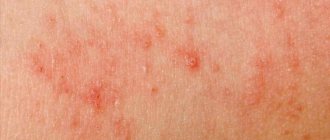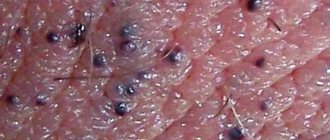A lump on the pubis in men and women can signal the progression of many pathologies. According to statistics, about 60% of patients admitted to the hospital with a similar symptom notice negative signs in the body at later stages of the development of the pathology.
Therefore, treatment of a lump in the groin proceeds in an intensive mode. However, it happens that a lump on the pubis in women and men is an ordinary boil or ingrown hair and does not require surgical treatment.
Causes of compaction formation
A seal on the pubis in men and women signals the development of many pathologies in the body: these can be diseases of the musculoskeletal system, skin and lymphatic diseases. The cause of the development of a lump above or below the pubis can be determined after a comprehensive diagnosis.
The situation may become a little clearer if you familiarize yourself with the general picture of the pathologies that led to the appearance of the swelling. A lump in the pubic area: what is it, what pathologies can be caused - below are the main reasons for the appearance of lumps.
Hernia
If the ball is red and hurts when pressing and walking, this may indicate the development of an inguinal hernia. Men are more susceptible to the disease. Most often, the pathology occurs against the background of frequent overeating and muscle tension.
The subcutaneous neoplasm is initially small in size (from 0.5 to 2 cm). As the hernia progresses, the tumor can grow up to 5 cm. The hernia tumor has a soft consistency, and the pain may intensify upon palpation. It is not possible to eliminate the tumor on your own. If it grows, surgical intervention will be required.
Lipoma
If the ball in the groin does not hurt, this indicates the development of a benign neoplasm - lipoma. Women are more susceptible to the development of pathology (including during pregnancy). A benign ball in the groin area does not harm the patient’s health and does not develop into an oncological tumor. Most often, it measures up to 2-3 cm. Causes of lipoma:
- unhealthy lifestyle: abuse of nicotine products, frequent alcohol consumption, unbalanced diet;
- high blood cholesterol levels;
- hormonal disbalance;
- genetic predisposition.
A small subcutaneous ball, although it does not cause pronounced symptoms, still requires timely treatment. In the early stages, you can get rid of the tumor using topical products. In advanced cases, surgical removal of the lipoma will be required.
Cyst
A ball in the groin in women and men can be a sebaceous cyst. The pathology is formed when the duct of the sebaceous gland is blocked.
A ball-shaped seal in this case appears for the following reasons:
- failure to comply with hygiene standards;
- excessive sweating;
- excess weight and endocrine disorders;
- hormonal disbalance;
- injury to the problem area;
- improper hair removal in women.
The ball under the skin in the groin has a hard consistency. It is easily palpable and begins to cause discomfort upon palpation. Over time, the tumor tends to grow and fester.
A neoplasm with pus inside is dangerous to human health, since if the internal capsule bursts and its contents enter the bloodstream, it can become infected. The cyst is removed surgically. In some cases, it resolves on its own. Photos of the cyst can be seen on online medical portals.
Ingrown hair
If the seal between your legs in the groin hurts when you touch it, this also indicates the appearance of an ingrown hair. Most often, girls encounter this pathology due to improper hair removal of the intimate area.
The ball under the skin usually reaches 1-2 cm in size, causes discomfort when walking, becomes covered in a rash and itches. As the inflammatory process progresses, groups of small balls may form on the skin, causing severe discomfort. Tumor-like formations can be removed using specialized ointments (at an early stage) or surgery (in more advanced cases).
Furuncle
If a hard ball appears to the right or left of the pubis, which itches and causes discomfort, this indicates the appearance of a boil. These are dense neoplasms that form when infections and bacteria enter the body. Also, a boil can develop against the background of the following pathologies:
- diseases of the endocrine system;
- liver and kidney pathologies;
- allergic reactions.
Also, a neoplasm can appear due to excessive sweating and blockage of the sebaceous glands. Pathology is treated with external agents. After recovery, relapses are possible.
Inflamed lymph node
If a ball with clear boundaries has formed between the legs of a child or an adult, which is easily palpable upon palpation, this indicates inflammation of the lymph nodes. In this case, the neoplasms are painful when touched. Additional symptoms include redness, itching, and burning.
Lymph nodes become inflamed for the following reasons:
- STDs (gonorrhea, syphilis);
- gynecological diseases;
- HIV;
- pathologies of the lymphatic system;
- prostate diseases;
- oncological neoplasms.
It is forbidden to touch inflamed lymph nodes with your hands, try to squeeze them out or comb them. Treatment in this case is carried out both locally and surgically.
Varicose veins of the superficial femoral veins
Predominantly a female disease. Most often, varicose veins develop against the background of prolonged physical exertion and prolonged exposure to a static position.
It is not uncommon for pathology to occur in women during pregnancy. As varicose veins progress, the patient develops a dense lump on the skin that can be easily felt with the fingers. The tumors hurt, pulsate, and cause discomfort when walking.
Neurofibroma
A benign neoplasm that develops in the groin area in the layers of connective tissue. Neurofibroma rarely develops into a malignant tumor.
In the initial stages, the pathology is not accompanied by negative symptoms. However, the disease should not be ignored in any case. As neurofibroma progresses, the ball under the skin tends to grow deep into the periosteal tissue and form painful growths.
Hygroma
A harmless growth under the skin, which is a type of cyst. The tumor appears as a result of the accumulation of secretions between the tendons when they are constantly in a state of tension. Most often, hygroma forms on the wrists, but there are cases of its appearance in the groin area.
Other reasons
A ball in the groin in men and women often appears with the development of the following pathologies in the human body:
- female gynecological diseases (thrush, erosion, andexitis);
- viral infections that affect the entire human body (flu, herpes, rubella);
- diseases of the urinary system;
- dermatological skin diseases.
A lump in the groin area may be a symptom of a fungal infection.
How to treat
From the above, it is obvious that a medically incompetent person is unlikely to be able to accurately determine what a lump is. Therefore, it is worth consulting with your doctor.
And even a professional, before making a final diagnosis, will have to conduct a differential diagnosis.
If the doctor considers that the problem should be removed, one or another modern method is used:
- surgical;
- laser;
- radio wave.
In the first case, a scalpel is used. Some consider the technique outdated, and it is sometimes painful. However, it is the cheapest, and therefore is still popular.
Laser cauterization is an effective method, since, unlike mechanical action with a scalpel, the formation will definitely be completely removed. Destruction by radio waves is also an effective method.
But, as a rule, they are not limited to one removal. The doctor prescribes a course of antibiotics if the formation is caused by an infection. The wound is treated every day with an ointment recommended by the doctor.
Symptoms
The ball on the skin in the groin can behave differently. Most often, patients note the following general symptoms when a lump appears:
- pain on palpation and walking. Discomfort may radiate to the stomach and pelvic area;
- enlargement of nearby lymph nodes;
- the appearance of excessive pigmentation (redness, bluish discoloration of the skin), development of itching, irritation;
- deterioration in general health (apathy, fatigue, loss of appetite, increased body temperature).
If the ball under the skin does not go away for a long time and provokes a deterioration in the patient’s general condition, it is necessary to consult a doctor for diagnostic tests.
Rash between the legs in women: sexually transmitted infections
Sexual diseases often cause an alarming symptom - rashes in the intimate area. Pimples, vesicles, ulcers, and erythemas accompany the progression of the following sexually transmitted infections:
- Genital herpes
. This virus is present in the body of 99% of women. When the immune system is weakened, herpes type 2 actively affects the skin and mucous membranes of the genital organs. The woman's groin becomes covered with small whitish blisters filled with liquid. On the 2-3rd day of illness, the pimples burst, and in their place weeping ulcers form. The rash from genital herpes can last for months. Therapy helps achieve remission, but it is impossible to cure the disease. - Gonorrhea .
Affects the internal and external genitourinary tract. When infected with gonorrhea, women develop small ulcers on the mucous membranes. Often the first ulcers form on the labia minora. An ulcerative rash is accompanied by purulent vaginal discharge, itching and burning in the perineum. Sometimes a woman develops a fever. The gonorrhea rash is red and hurts when in contact with clothing; - Gardnerellosis
. This is a bacterial infection of the vulvar mucosa. The disease is accompanied by ulcerative rashes on the mucous membranes of the groin. Small ulcers cover the labia, vulva, and sometimes spread to the anus. Additional symptoms are itching, burning, swelling of the external genitalia, watery vaginal discharge. - Molluscum contagiosum
. This is a viral skin disease. Appears after infection with the smallpox virus. In this case, small nodules and compactions form on the pubic part of women, which are located singly or in groups. The skin of the genitals takes on a pink color. Seals and nodules are practically not felt to the touch. When pressing on the rash, a white liquid appears. The rash does not hurt or itch. With this disease, rashes affect the pubis, genitals, inner thighs, and anus.
Diagnosis and treatment
A specialist may prescribe the following diagnostic tests to establish a diagnosis:
- general blood and urine analysis;
- hormonal study;
- autoimmune research;
- scraping (if skin pathologies are suspected);
- tests for STDs;
- Ultrasound of the groin area;
- MRI;
- puncture (if cancer is suspected).
Treatment tactics depend on the diagnosis:
- pathologies resulting from blockage of the sebaceous glands are treated with ointments and creams for external use; in advanced cases, the tumor is excised by a surgeon;
- cystic formations in most cases are removed surgically;
- viral pathologies are treated with antibiotics, antiviral and immunostimulating agents;
- STDs are eliminated with antibiotics, antifungals and anti-inflammatory drugs.
Preventive measures
As a rule, it is quite possible to avoid the occurrence of a pathological process. To do this, you must adhere to several rules:
- use protective equipment during sexual intercourse;
- pay special attention to intimate hygiene - take a shower in the morning and evening, using soap or another antiseptic;
- Promptly disinfect any areas of possible infection.
The formation of purulent lumps can be caused by many factors. Basically, these formations do not pose a serious health hazard, but they often cause quite severe painful sensations that interfere with leading a normal lifestyle.
Therefore, it is extremely important to start treatment on time, as well as follow preventive measures to avoid their recurrence.
Risk group
As practice shows, the likelihood of tumors appearing in the genitourinary system increases in men:
- Those who abuse tobacco products. According to statistics, kidney cancer is diagnosed in smokers 2 times more often.
- Middle aged (after 45 years). This is due to a decrease in the level of male sex hormones along with an increase in female ones.
- People who work in hazardous industries (for example, when a person often comes into contact with hazardous chemicals).
- Those who have been on dialysis for a long time. This often leads to kidney cancer.










